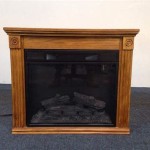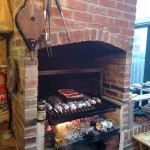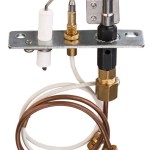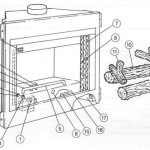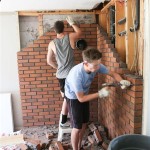Interior Design Considerations: Mounting a TV Above a Fireplace
Mounting a television above a fireplace is a popular interior design choice, often driven by the desire to maximize space and create a focal point within a room. However, this seemingly straightforward decision involves a complex interplay of aesthetic considerations, practical challenges, and potential safety concerns. A poorly executed installation can detract from the overall design, compromise viewing comfort, and even damage the equipment or the structural integrity of the wall. This article will delve into the key considerations for successfully integrating a TV above a fireplace, exploring aspects ranging from architectural compatibility to ergonomic positioning and heat management.
Evaluating Architectural Compatibility and Structural Integrity
The first step in determining the feasibility of mounting a television above a fireplace is a thorough assessment of the architecture and structural integrity of the fireplace and surrounding wall. Not all fireplaces are suitable for this type of installation. Factors such as the fireplace material (brick, stone, concrete, or drywall over framing), the presence of a chimney, its configuration, and the overall wall structure must be carefully examined. A brick or stone fireplace, while aesthetically appealing, presents unique challenges due to the difficulty of drilling and securing mounting hardware. Concrete fireplaces offer similar challenges, requiring specialized tools and anchors.
Drywall over framing, while seemingly easier to work with, requires careful attention to the stud locations and the load-bearing capacity of the wall. Many fireplaces have a decorative mantel that may need to be removed or modified. It is critical to ensure that the wall can adequately support the weight of the television, the mounting bracket, and any associated wiring. A general rule of thumb is to consult with a structural engineer or a qualified contractor to assess the wall's load-bearing capacity, especially for larger and heavier televisions. Failure to do so can result in the television falling from the wall, causing damage and potential injury.
Furthermore, the type of fireplace itself can impact the installation. Wood-burning fireplaces generate significantly more heat than gas or electric fireplaces. This increased heat presents a greater risk to the television's internal components, as consistent exposure to high temperatures can shorten its lifespan and even cause permanent damage. The presence of a chimney also influences the available space and the routing of cables. Older homes may have chimneys that extend further into the wall, limiting the depth available for mounting the television. A professional assessment of the fireplace and surrounding wall is crucial to identifying any potential obstacles and ensuring a safe and aesthetically pleasing installation.
Addressing Heat Management and Ventilation
One of the most significant concerns when mounting a television above a fireplace is heat management. Televisions are electronic devices sensitive to high temperatures. Prolonged exposure to the heat rising from a fireplace can damage delicate internal components, leading to malfunctions, reduced lifespan, and even complete failure. The radiant heat from a wood-burning fireplace poses the greatest threat, but even gas and electric fireplaces generate enough heat to be a concern. Therefore, implementing effective heat management strategies is paramount.
One primary method of mitigating heat exposure is to create a physical barrier between the fireplace and the television. A sufficiently deep mantel, if architecturally appropriate, can deflect a significant amount of rising heat. The mantel should ideally extend several inches above and beyond the fireplace opening to provide adequate protection. Another approach is to install a heat shield or deflector. These shields are typically made of metal and are designed to redirect the heat away from the television. They can be custom-made to fit the specific dimensions of the fireplace and television.
Proper ventilation is also crucial for dissipating heat. The space behind the television should be well-ventilated to prevent the buildup of hot air. This can be achieved by ensuring adequate clearance between the television and the wall and by incorporating ventilation openings in the surrounding structure. Some installers even recommend installing small fans behind the television to actively circulate air and dissipate heat. The type of mounting bracket used can also influence ventilation. Tilting or articulating brackets allow for greater airflow behind the television compared to flush-mounted brackets. Regularly monitoring the temperature above the fireplace, especially during periods of heavy use, is important to ensure that the television is not being exposed to excessive heat.
Choosing the right type of fireplace can also impact heat management. Electric fireplaces, which produce heat on demand, are generally considered a safer option than wood-burning or gas fireplaces. They allow for greater control over the heat output and can be used without generating any heat at all, providing ambiance without the risk of damaging the television. Careful consideration of these factors is crucial for ensuring the long-term performance and reliability of the television.
Optimizing Viewing Height and Ergonomics
Beyond structural and thermal considerations, the viewing height and ergonomics are critical factors in achieving a comfortable and enjoyable viewing experience. Mounting a television too high can lead to neck strain and fatigue, particularly during extended viewing sessions. The ideal viewing height is generally considered to be at eye level when seated. However, when mounting a television above a fireplace, this ideal is often compromised due to the height of the fireplace itself.
To mitigate this issue, careful consideration must be given to the height of the fireplace, the size of the television, and the viewing distance. A general guideline is to position the bottom edge of the television screen no more than approximately 4 feet above the floor. This height may need to be adjusted depending on the specific circumstances. For instance, if the viewing distance is greater, the television can be mounted slightly higher without causing discomfort. Conversely, if the viewing distance is close, the television should be mounted lower.
The use of a tilting or articulating mounting bracket can also improve the viewing experience. These brackets allow the television to be tilted downward, compensating for the elevated position and reducing neck strain. Articulating brackets offer even greater flexibility, allowing the television to be adjusted to different viewing angles. This can be particularly useful in rooms with multiple seating areas or where the viewing position varies. Before finalizing the mounting height, it is recommended to simulate the viewing experience by temporarily propping up the television at different heights to determine the most comfortable position. Taking the time to carefully evaluate the ergonomic considerations will significantly enhance the overall viewing experience and prevent discomfort.
Another aspect of ergonomics is the distance between the viewer and the screen. Too close, and the image may appear pixelated or overwhelming; too far, and details can be lost. A common rule of thumb is to multiply the screen size (measured diagonally) by 1.5 to 2.5 to determine the optimal viewing distance in inches. Adjustments can be made based on personal preference and viewing habits, but this rule provides a solid starting point. Proper consideration of viewing height, distance, and the use of adjustable mounting brackets will contribute to a more comfortable and visually pleasing experience.
In conclusion, mounting a TV above a fireplace requires careful planning and execution. These key points provide a foundation for a successful installation, encompassing architectural compatibility, heat management, and ergonomic considerations. A comprehensive approach, considering all these factors, will lead to a visually appealing and functional installation.

Living Room Decorating And Design Ideas Inspiration Decor Designs

Contemporary Modern Fireplace Designs With Tv Above Mantel
:max_bytes(150000):strip_icc()/CarinaSkrobeckiPhoto_22021SE32ndSt_22-70a79cdf77c44aa6959259ebfb7f9f69-62bcab6ff8c045b2929bf14461a94288.jpg?strip=all)
35 Ways To Make The Tv Over A Fireplace Look Better

49 Exuberant S Of Tvs Mounted Above Gorgeous Fireplaces Home Fireplace Living Room With
:max_bytes(150000):strip_icc()/Richmond-VA-Historic-TownHouse-11-86008c314a974f1e9cdbb216c831e36d.png?strip=all)
35 Ways To Make The Tv Over A Fireplace Look Better

Should You Mount Your Tv Above A Fireplace Digital Trends

30 Modern Fireplace Tv Wall Ideas To Upgrade Your Home Alittledelightful

Putting A Tv Above Your Mantel Summer Adams

Design Debate Is It Ok To Hang The Tv Over Fireplace

19 Stylish Yet Practical Electric Fireplace Ideas With Tv Above White Shiplap Wall
Related Posts

